This year, a keynote address at the Washington State Horticultural Association annual meetingthe Batjer Addresswill be given twice, once in English, once in Spanish, by a speaker who is bilingual from birth and speaks flawlessly and passionately in both languages. He is now one of the leading “philosophers” of orchard design in the world. Dr. Terence Robinson, who has been at Cornell University in Geneva, New York, since 1984, will speak about his vision of apple and pear orchards of the future. While Robinson has forged his reputation on the wet side of the American continent, his roots lie in the irrigated orchards of the arid West. He earned both his master’s degree and his doctorate from Washington State University. He was born and raised in Casas Grandes, in Mexico’s Chihuahua State, on a family fruit farm operated today by his two brothers. It was his mother’s influence, he said in an interview with Good Fruit Grower, that sent him off to college after he graduated as high school valedictorian in 1973. On the Cornell Web site, Robinson sums himself up very briefly: “I am an applied fruit crop physiologist. My goal is to solve practical fruit production problems that will increase the profitability and strength of the New York fruit industry and fruit growers around the world. My program is largely field oriented and of an applied nature.” Robinson takes pride in that his research is driven by growers’ needs and that he is driven by data. When he talks to growers, his clearly stated conclusions are supported by data slides documenting results of carefully constructed research projects. One project that turned out to be most important started in 1993. Cornell researchers planted, on the New York farm of Bob and Eric Brown, test plots to look at apple performance under different planting densities”extremes in density,” Robinson said.
Birth of tall spindle
The late 1990s were not good years for apple growers, and in 2000, New York apple growers put together a strategic planning group, led by fruit grower George Lamont. The group “assigned Cornell the task,” in Robinson’s words, of coming up with a production system that would allow the New York apple industry to survive economically. That’s when he and his cohorts at Cornell began looking closely at the 1993 plantings. And that led to the birth of the high-density tall spindle system. “It contained ideas from slender spindle, vertical axe, Solaxe, super spindle, all from Europe. We packaged it and put a new name on it in 2002, and we started pushing it in 2003,” he said. Since then, adoption of the tall spindle system has grown every year, driven by more and more new data showing its economic superiority. It is being widely adopted in New York, Michigan, the Northeast, and the Mid-Atlantic. It has won enthusiastic supporters among growers and extension educators like Phil Schwallier in Michigan, Mike Fargione in New York, and Jon Clements in Massachusetts. Clements has developed a Web site where anyone can find lectures, PowerPoint presentations, and videos explaining how to grow and manage a tall spindle orchard. In Washington State, thinking remains divided, Robinson said. Stemilt Growers is adopting tall spindle, while others are going with the Auvil-style V-trellis system.
Basic elements
Robinson and his colleagues continue to revise the basic system. He works closely with Steve Hoying, Mike Fargione, and Alison DeMarree in New York. The basic elements of tall spindle are these, as described in a paper by Robinson, Hoying, and Fargione: High density. The optimum tall spindle spacing for an average vigor variety and soil is 3 feet by 11 feet, or 1,289 trees per acre. Full dwarfing rootstocks. The most successful tall spindle orchards established to date have been on M.9 and B.9. Precocious dwarfing stocks are important since early cropping is essential. Cornell is also developing a series of rootstocks resistant to fireblight and replant disease. Highly feathered nursery trees. Nursery stock ideally have from 10 to 15 feathers per tree. Minimal pruning at planting. No heading. Support system. To carry the crop and support potentially brittle rootstocks. Branch devigoration. Upright scaffold branches are devigorated by bending them below the horizontal. This early investment of labor pays off in early cropping and less pruning later. Limb renewal. All scaffolds are removed as they become too large for the available space and become out of balance within the tree. Early fruiting. Fruiting in the second and third leaf is essential to keep a low tree vigor level and provide income from early fruit sales. In tests, this system achieved cumulative production of more than 3,000 bushels in the first five years, resulting in a 40 percent higher crop value than the slender vertical axis and Sol Axis planting systems.
Future vision
In addition to high, early yields, a key goal is to increase the percentage of high quality fruit, Robinson said. That means having narrow canopies that allow good exposure to light from bottom to top. This has led Robinson to examine the work of Alberto Dorigoni in Italy, who is narrowing canopies with mechanical hedging to form tree walls, and Robinson’s work last year focused on finding the best timing for hedging. The next economic challenge is labor reduction. “We need to grow apples with half the labor we now use,” he said. That gives him a target of 180 hours per acre, compared with about 360 now. Key ingredients are machinesplatforms to thin, prune, and serve as carriers for harvest crews, but also hedgers to do much of the pruning now done by hand. Chemicals play a role as well. Chemical thinning can cut thinning labor by half, and Robinson has been working with colleague Dr. Alan Lakso to develop a carbohydrate model to make chemical thinning more effective. The model predicts the sensitivity of fruitlets to drop, set, and thinning, based on the carbohydrate balance in the tree. A new high-density tall spindle orchard was planted at Thome Orchards this spring. Features include trickle irrigation, feathered trees, four-wire trellis, posts every 30 feet, and bamboo stakes at every tree. Left: Terence Robinson and Phil Schwallier team up to explain summer hedging to a crowd of 200 in Thome Orchards. Wind machines in the background have become a common feature on Fruit Ridge, many of them added after the big freeze of 2012.

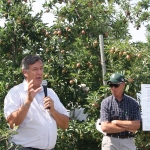
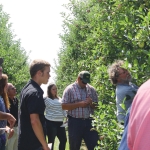
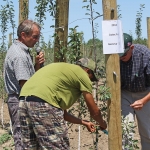
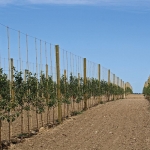
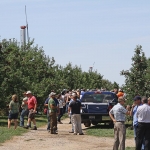





Leave A Comment